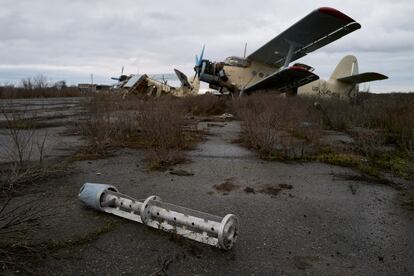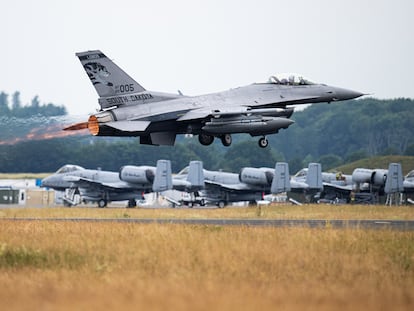Cluster bombs: the controversial weapon Kyiv hopes will turn tide of counteroffensive
Washington has agreed to supply Ukraine with a munition that has been banned by over 100 countries and which will wreak havoc on the civilian population for decades after the end of the war

The United States did not include cluster bombs in the previous 41 military aid packages approved for Ukraine since the beginning of the Russian invasion, but it did so in the most recent one announced last week by the Pentagon, which gave the green light for the shipment of a type of weaponry banned by more than 100 countries. Joe Biden, under pressure from Kyiv, congressional Republicans, and the National Security Council, relented earlier this month and argued that these bombs are needed to alleviate shortages of artillery ammunition. “It was not an easy decision,” the U.S. president said while justifying a move criticized by some of Washington’s allies, including Germany, Spain, and Canada. Ukraine hopes that the use of cluster bombs will aid a breakthrough in the ongoing counteroffensive against the lines of Russian fortifications stretching along the more than 1,000-kilometer (620-mile) front.
The Ukrainian government has been pressing for the delivery of cluster munitions from Washington since February 2022. These bombs, free-falling or guided, can be dropped from aircraft and fired from ships and artillery pieces. The devices contain a mechanism that releases dozens of submunitions into the air and spreads them over an area similar in size to a football field. The cluster bombs that the U.S. has pledged to supply to Ukraine will be used only by artillery. The Pentagon has a huge stockpile of so-called dual-purpose improved conventional munitions (Dpicm). The Dpicm that Washington will deliver to Kyiv are fired from 155-millimeter caliber guns and each contains 88 submunitions designed to kill the largest numbers of enemy troops and to destroy armored vehicles.
Mark Cancian, a retired U.S. colonel and Washington-based researcher at the Center for Strategic and International Studies (CSIS), explains via telephone that three reasons have prompted Biden’s change of stance. On the one hand, the shortage of artillery ammunition in Western arsenals and “the inability to increase production at the pace that Ukraine requires.” The Ukrainian Army fires between 2,000 and 7,000 shells every day, compared to between 20,000 and 50,000 fired by Russian forces. Valerii Zaluzhnyi, the commander-in-chief of the Ukrainian Armed Forces, told The Washington Post a few days ago that his troops use “10 times less artillery” than the Russians. Washington has already provided more than two million shells and other Western allies have supplied hundreds of thousands more, but they are insufficient for a war with such intensity of artillery fire. The United States has announced that it will increase its artillery ammunition production sixfold by 2028, but so far it has only managed to raise it from 14,000 shells a month before the war to just over 20,000 a month now.
The second reason cited by Cancian is the Ukrainian government’s commitment to use cluster munitions only against military targets, and in zones far from populated areas. The Kyiv authorities argue that the terrain where cluster munitions will be deployed is already heavily infested with Russian anti-personnel mines and cluster submunitions. The Ukrainian government also states that the risk of civilians suffering long-term consequences from the use of cluster bombs is less than that of remaining under Russian occupation. The third reason the CSIS researcher highlights is the pressure placed on Biden by his military advisors and several prominent Republican congressmen. “That pressure is the same pressure that caused him to give in to the delivery of other types of sophisticated weaponry, such as Patriot anti-aircraft missile batteries, Himars multiple missile launchers, Abrams tanks or F-16 fighters,” Cancian notes.
“A turning point”
Oleksii Reznikov, Ukraine’s defense minister, declared a few days ago that cluster bombs will be “a turning point” in the course of the counteroffensive launched in June. Kyiv’s forces are trying to break through the three Russian defensive lines at several points along the front. Ukrainian soldiers are attempting to advance along around 30 kilometers (18 miles) of terrain riddled with mines and anti-tank obstacles, while under constant attack by drones and Russian artillery. “Cluster bombs will allow for much greater effectiveness against entrenched enemy troops,” Cancian notes, adding that they will also serve as cover fire for Ukrainian sappers to clear minefields. Washington argues that cluster bombs will enable the Ukrainian Army to counter Russian artillery and manpower superiority, while reducing the use of conventional shells and the attrition of howitzers.
U.S. Deputy Defense Secretary Colin Kahl stated that cluster bombs destined for Ukraine have a failure rate of 2.35%, according to estimates drawn from tests conducted between 1990 and 2020, the results of which are confidential. The Pentagon claims that more than 40% of Russian cluster bomb submunitions fail to explode.
The Kremlin responded to Washington’s announcement by threatening to start using the same weaponry. However, the Russian military has being deploying cluster munitions since the beginning of the war. The Cluster Munition Coalition (CMC), a Geneva-based NGO, estimates that Russian-delivered cluster bombs killed nearly 700 civilians in the first six months of the war. The deadliest attack was on the Kramatorsk train station in Donetsk province in April 2022, in which 61 people were killed and more than 150 injured.

Kyiv has committed to keep a record of each use of cluster munitions on the battlefield, in order to prioritize those areas for demining if they are finally liberated. Even so, the Ukrainian Army denies having so far used such bombs, despite the fact that various international organizations maintain that it has deployed Soviet-era cluster weapons that it had kept in its arsenals. Human Rights Watch claims that a cluster bomb dropped by Ukraine killed eight civilians and wounded 15 in an attack in Izium in the spring of 2022.
More than 100 countries have ratified the 2008 Convention on Cluster Munitions, including most NATO members. Neither Ukraine, Russia or the United States are signatories, but some of the allies who have publicly criticized Biden’s decision, such as Canada, Spain, Germany and, more tepidly, the United Kingdom, are. NATO Secretary General Jens Stoltenberg declared that the alliance has no formal position on the use of cluster bombs on the battlefield. Finland, Latvia, Estonia, Poland and Romania, some of Russia’s closest territorial neighbors, have also not ratified the convention banning the production, distribution, and use of this weaponry.
Cluster bombs have been used in countless wars since Nazi Germany’s Condor Legion dropped a prototype in the bombing of Guernica in 1937. In recent years, they have been used in Libya, Syria, Yemen, and in the Nagorno-Karabakh conflict, by both Armenia and Azerbaijan. Between 55,000 and 90,000 civilians have been killed worldwide by unexploded cluster submunitions, according to various estimates.
The governments of Laos and Cambodia, two of the countries with the highest proportion of land contaminated by cluster bombs, have expressed concern about the use of this weaponry in Ukraine. At least 20,000 Laotians, mostly children, have been killed or faced amputation due to cluster submunitions since the end of the Vietnam War in 1975. U.S. aircraft dropped more than two million tons of such bombs on Laos, and most of the victims have been civilians who were born after the end of the war. The CMC estimates that it will take another 100 years to remove all the explosive charges dropped on Laos by U.S. forces.
Sign up for our weekly newsletter to get more English-language news coverage from EL PAÍS USA Edition
Tu suscripción se está usando en otro dispositivo
¿Quieres añadir otro usuario a tu suscripción?
Si continúas leyendo en este dispositivo, no se podrá leer en el otro.
FlechaTu suscripción se está usando en otro dispositivo y solo puedes acceder a EL PAÍS desde un dispositivo a la vez.
Si quieres compartir tu cuenta, cambia tu suscripción a la modalidad Premium, así podrás añadir otro usuario. Cada uno accederá con su propia cuenta de email, lo que os permitirá personalizar vuestra experiencia en EL PAÍS.
¿Tienes una suscripción de empresa? Accede aquí para contratar más cuentas.
En el caso de no saber quién está usando tu cuenta, te recomendamos cambiar tu contraseña aquí.
Si decides continuar compartiendo tu cuenta, este mensaje se mostrará en tu dispositivo y en el de la otra persona que está usando tu cuenta de forma indefinida, afectando a tu experiencia de lectura. Puedes consultar aquí los términos y condiciones de la suscripción digital.
More information
Archived In
Últimas noticias
All the effects of gentrification in one corner of Mexico’s Colonia Roma
Palestinian reporter Youmna El Sayed: ‘My family told me I had to choose between being a journalist or a mother’
The new language of the workplace: Knowing how to ask AI questions is more important than using it
Russell Tovey: ‘I was advised many times not to come out, I don’t think there was many people who’d done that — and I feel really proud that I’m one of those that did’
Most viewed
- The low-cost creative revolution: How technology is making art accessible to everyone
- Christian Louboutin: ‘Young people don’t want to be like their parents. And if their parents wear sneakers, they’re going to look for something else’
- US sanctions against jailed cartel leader ‘El Marro’ highlight Mexico’s lack of control over its prisons
- Liset Menéndez de la Prida, neuroscientist: ‘It’s not normal to constantly seek pleasure; it’s important to be bored, to be calm’
- Cartels in Mexico take a leap forward with narco-drones: ‘It is criminal groups that are leading the innovation race’











































